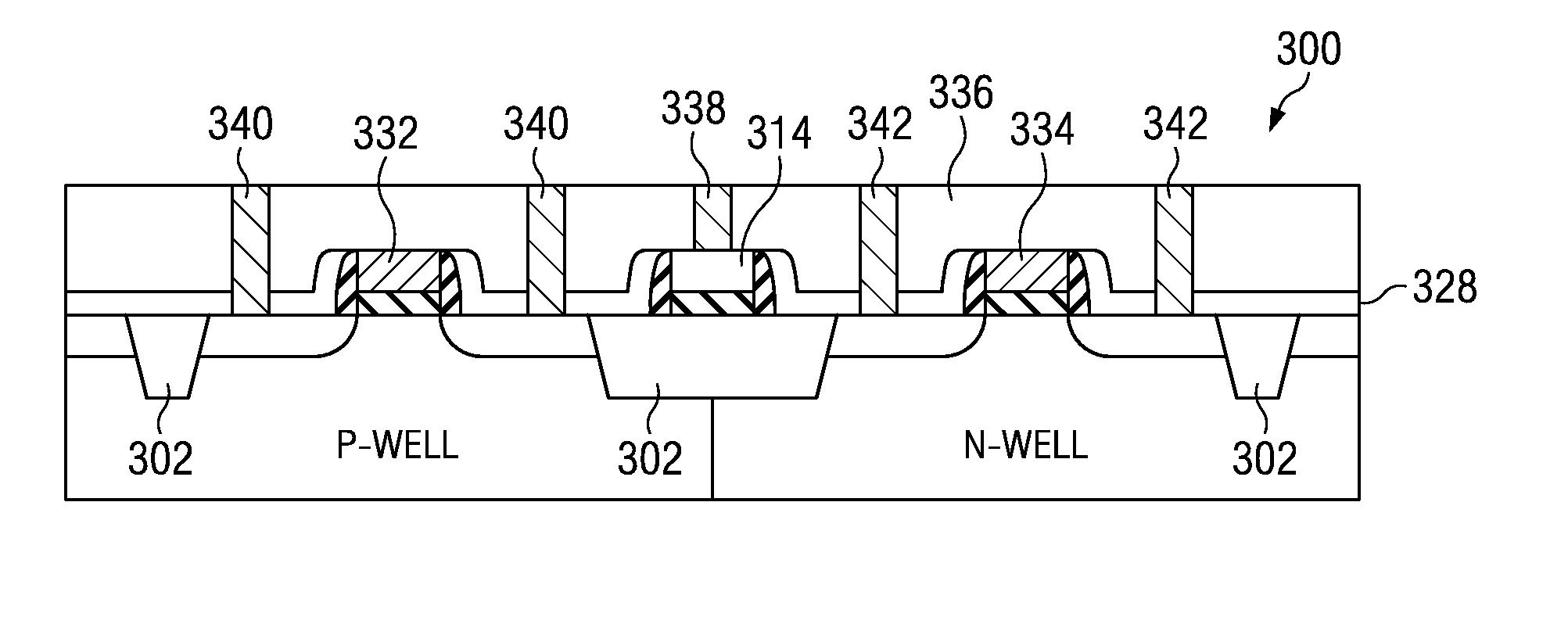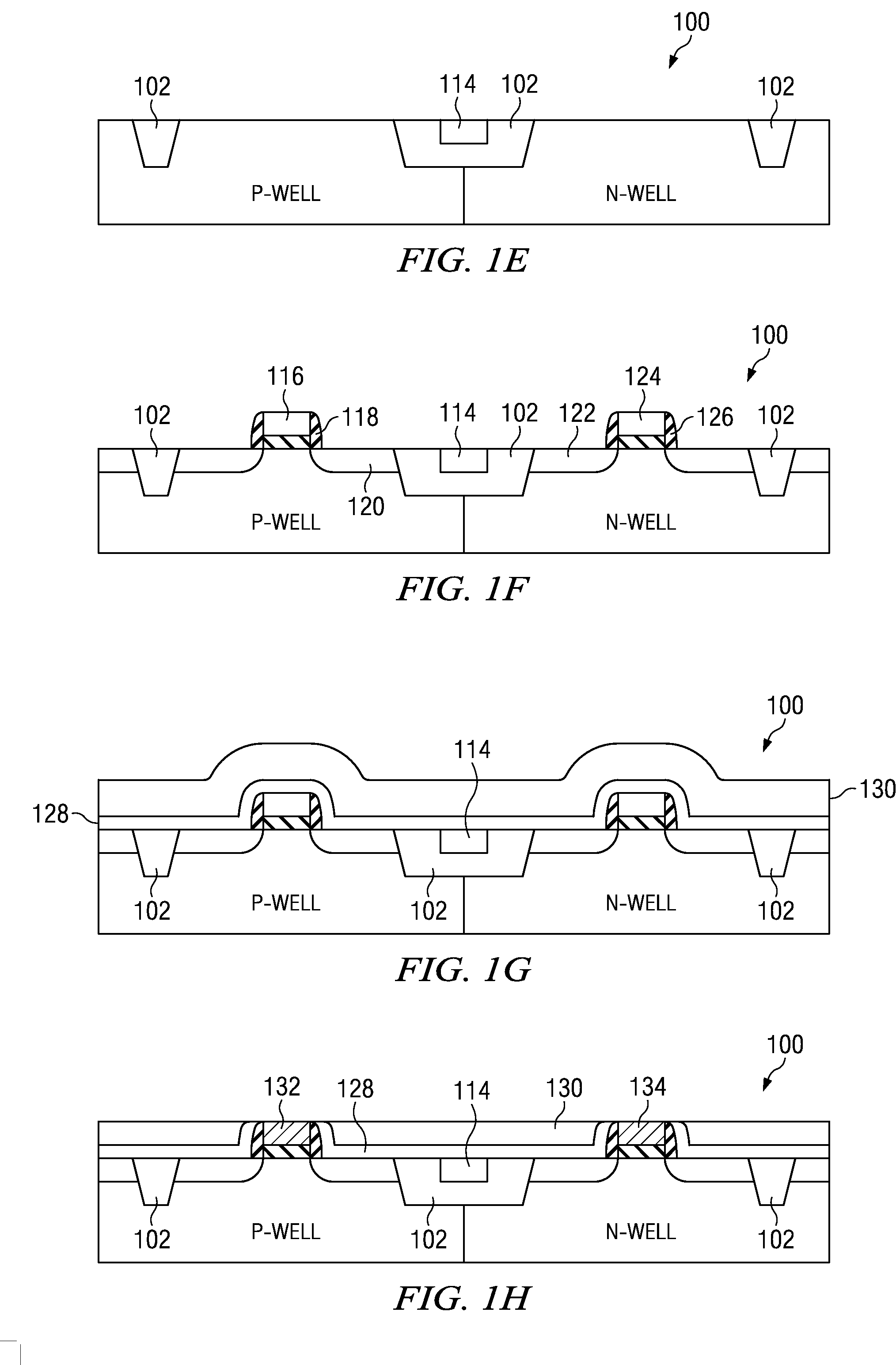Polycrystalline silicon efuse and resistor fabrication in a metal replacement gate process
a metal replacement gate and polycrystalline silicon technology, applied in semiconductor devices, semiconductor/solid-state device details, diodes, etc., can solve the problems of increasing challenges in semiconductor integrated circuit processing, presenting compatibility issues with other integrated circuit features, and polycrystalline silicon no longer readily available for efuses
- Summary
- Abstract
- Description
- Claims
- Application Information
AI Technical Summary
Benefits of technology
Problems solved by technology
Method used
Image
Examples
first embodiment
[0008]Referring now to FIGS. 1A through 1I there are diagrams of a simplified process flow according to the present invention. FIG. 1A illustrates a semiconductor substrate 100 having shallow trench isolation (STI) regions 102 as is well known in the art. The left half of the substrate is designated p-well as a bulk terminal for re-channel metal oxide semiconductor (NMOS) transistors. The right half of the substrate is designated n-well as a bulk terminal for p-channel metal oxide semiconductor (PMOS) transistors. Here, and in the following discussion, drawing figures illustrate a simplified fabrication process flow rather than a particular circuit. The drawing figures are not to scale, and the same reference numerals are used to identify similar features.
[0009]At FIG. 1B, a hard mask 106 is formed over the substrate 100 of FIG. 1A. The hard mask is generally an inorganic anti-reflective coating (IARC) and may be silicon nitride (SiN), silicon carbide (SiC), or other suitable materi...
second embodiment
[0017]Referring now to FIGS. 2A through 2F there are diagrams of a simplified process flow according to the present invention. FIG. 2A illustrates a semiconductor substrate 200 having shallow trench isolation (STI) regions 202 as is well known in the art. The left half of the substrate is designated p-well as a bulk terminal for NMOS transistors. The right half of the substrate is designated n-well as a bulk terminal for PMOS transistors.
[0018]At FIG. 2B, a dielectric layer 207 is formed over substrate 200. The dielectric layer may be thermally grown silicon dioxide or a deposited high-k dielectric such as SiON or SiN. Here, high-k refers to a dielectric generally having a relative permittivity greater than 10. A hard mask 206 is formed over the dielectric layer 207 of FIG. 2A. The hard mask is generally an IARC layer as previously described. A photoresist layer 204 is formed over the hard mask 206 layer and opening 208 is patterned in the photoresist layer.
[0019]At FIG. 2C, the har...
third embodiment
[0024]Referring now to FIGS. 3A through 3H there are diagrams of a simplified process flow according to the present invention. FIG. 3A illustrates a semiconductor substrate 300 having shallow trench isolation (STI) regions 302 as is well known in the art. The left half of the substrate is designated p-well as a bulk terminal for n-channel metal oxide semiconductor (NMOS) transistors. The right half of the substrate is designated n-well as a bulk terminal for p-channel metal oxide semiconductor (PMOS) transistors.
[0025]At FIG. 3B, a dielectric layer 307 is formed over substrate 300. The dielectric layer may be thermally grown silicon dioxide or a deposited high-k dielectric such as SiON or SiN. Here, high-k refers to a dielectric generally having a relative permittivity greater than 10. A conductive layer 312 is formed over the dielectric layer 307. The conductive layer 112 is preferably polycrystalline silicon and may be n-type, p-type, or undoped. A photoresist layer is formed and ...
PUM
 Login to View More
Login to View More Abstract
Description
Claims
Application Information
 Login to View More
Login to View More - R&D
- Intellectual Property
- Life Sciences
- Materials
- Tech Scout
- Unparalleled Data Quality
- Higher Quality Content
- 60% Fewer Hallucinations
Browse by: Latest US Patents, China's latest patents, Technical Efficacy Thesaurus, Application Domain, Technology Topic, Popular Technical Reports.
© 2025 PatSnap. All rights reserved.Legal|Privacy policy|Modern Slavery Act Transparency Statement|Sitemap|About US| Contact US: help@patsnap.com



